Last month, XPeng officially released the P7. Recently, we also received a high-performance four-wheel drive version of the P7 and after experiencing it for a week, my feeling is: this is a very balanced car. If you have a deep obsession with pure electric vehicles, it’s hard to reject the P7’s experience.
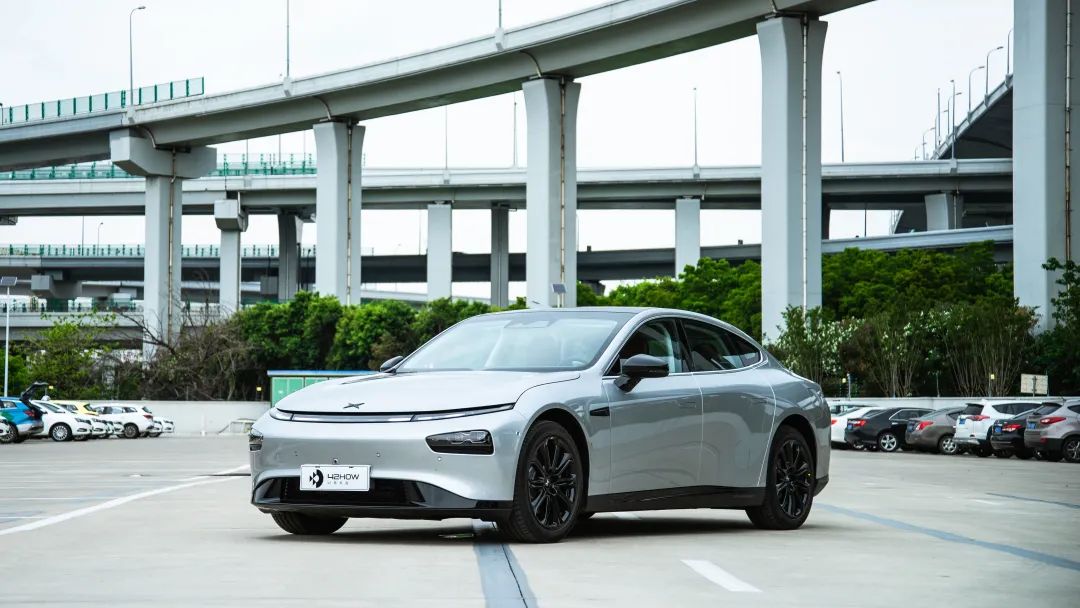
After receiving the car, we collected the focus of netizens on this car on the 42 Garage Weibo. The questions were mainly focused on three aspects: endurance, driving experience, and intelligent capability.
01. Surprisingly good endurance performance
We got a top-of-the-line P7 with four-wheel drive high performance, and an NEDC endurance of 552 km.

Although the four-wheel drive high-performance version and the ultra-long endurance version are equipped with the same 80.9 degree battery capacity, the four-wheel drive high-performance version has one more motor than the ultra-long endurance version, so the NEDC endurance will be slightly shorter.
XPeng P7’s entire lineup of NEDC endurance is over 550 km, with no major issues for daily city use. Therefore, this time, our endurance test is mainly focused on high-speed endurance.
Actual test of high-speed endurance
Under 42Test’s testing standards, the high-performance four-wheel-drive version of the P7 (80.9 degree battery) has a high-speed full-charge endurance of 416 km, and the displayed high-speed energy consumption is 18 kWh/100 km.
Considering that the P7 will face rivals like the Model 3 in the future, we locked the endurance goal for testing to the Model 3.
For fairness, we compared it to a Model 3 Performance with an NEDC endurance of 595 km.

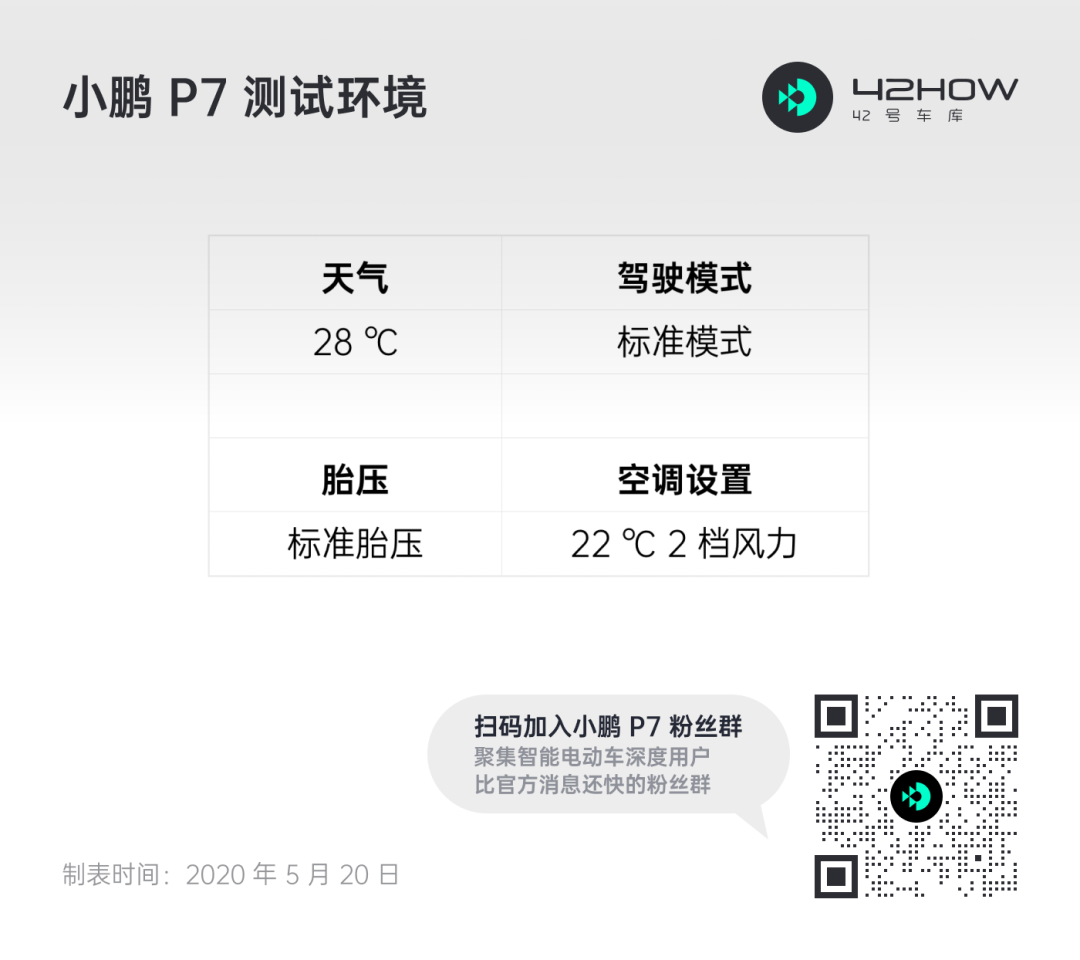
The high-speed endurance test was carried out according to the 42Test testing standard. The temperature on the day of the test was 28 degrees, and air conditioning was set at 22 degrees with the second gear wind speed. There were two people in each car, and the tire pressure was set to the default standard tire pressure at the factory.In addition, the P7 we received is a new car with a mileage of less than 30 km, and the Model 3 has a mileage of only 3000 km, which is basically a new car, so there will be no impact from battery degradation.
Furthermore, vehicle air resistance affects high-speed endurance, and both cars have achieved a very low level, with the P7 at 0.236 Cd and the Model 3 at 0.23 Cd.


We fully charged both vehicles’ batteries to 100% at Fengjing Service Area (the P7 has a labeled endurance of 552 km and the Model 3 has a labeled endurance of 497 km, with the Model 3 being under EPA conditions, so the corresponding NEDC is 592 km).
Upon departure, both cars maintained a speed of 120 km/h, and due to two traffic jams encountered on the way, totaling about 32 km, the average speed for the entire journey was 91 km/h.
In addition, the P7 we received has beta software and has not yet officially opened for assisted driving, so the P7 was driven entirely by the driver, while the Model 3 used assisted driving throughout the journey.

Initially, everyone believed that the P7 would lose in the endurance test, after all, looking only at the NEDC endurance, the Model 3 has a 43 km lead over the P7.
After driving at high speed for 401.5 km, both cars arrived at Zhuji Service Area together, with 20 km of labeled endurance remaining for the P7 and 18 km for the Model 3, corresponding to an NEDC endurance of approximately 21 km.
From the results of this test, the endurance of the P7 Performance model has already reached the same level as the Model 3 Performance.
 The interesting thing is that when we set the air conditioning of both cars to 22 degrees and 2nd gear wind, we can clearly feel that the P7 not only has a larger air volume than the Model 3, but also has a better cooling effect. In addition, considering the heavier weight of the P7, this result is quite amazing.
The interesting thing is that when we set the air conditioning of both cars to 22 degrees and 2nd gear wind, we can clearly feel that the P7 not only has a larger air volume than the Model 3, but also has a better cooling effect. In addition, considering the heavier weight of the P7, this result is quite amazing.
From the test results, the high-performance four-wheel drive model with the shortest endurance in the entire series actually exceeded 400 km in actual high-speed endurance, so there is no need to worry too much about the endurance of other versions, which can meet the daily travel needs of most users.
Charging speed test


XPeng P7 is one of the few brands that have built their own supercharging stations. Our test should have been carried out on XPeng’s own charging station, but considering that the maximum output power of XPeng’s supercharging station is only 90 kW, and P7’s 80.9 kWh battery can fully bear larger charging power, we found a third-party charging station with a peak power of 120 kW.
After our actual test, the peak charging power of XPeng P7 can reach 94 kW, and our most commonly used 10%-90% charging time is 54 minutes.
02 A Comfortable Family Sedan
Although the rear of this P7 is marked with the Performance logo, it has little to do with “performance” besides its powerful acceleration and braking. The overall tuning style is more comfort-oriented, and the tuning level has also reached the level of joint venture brands. Let’s look at it one by one.
Acceleration
The P7 four-wheel drive high-performance version adopts two permanent magnet synchronous motors. The maximum power of the front motor is 120 kW, the maximum torque is 265 N·m, the maximum power of the rear motor is 196 kW, the maximum torque is 390 N·m, and the total power is 316 kW, and the total torque is 655 N·m.
According to our actual test, the hundred-kilometer acceleration score in sport mode is 4.48 seconds. Although it is nearly 0.2 seconds slower than the official announced score, considering the weight of the P7 four-wheel drive performance version is over 2 tons, this is still a good performance.
Although the acceleration data of P7 is very strong, the initial power output of P7 will be relatively slow. It will not release the torque completely at the beginning. As can be seen from the acceleration curve of V-Box, the acceleration G value of 0-8 km/h is 0.63 g. The later stage torque release is more direct, and there will be a sustained pushing back feeling. The overall tuning is more suitable for daily driving.
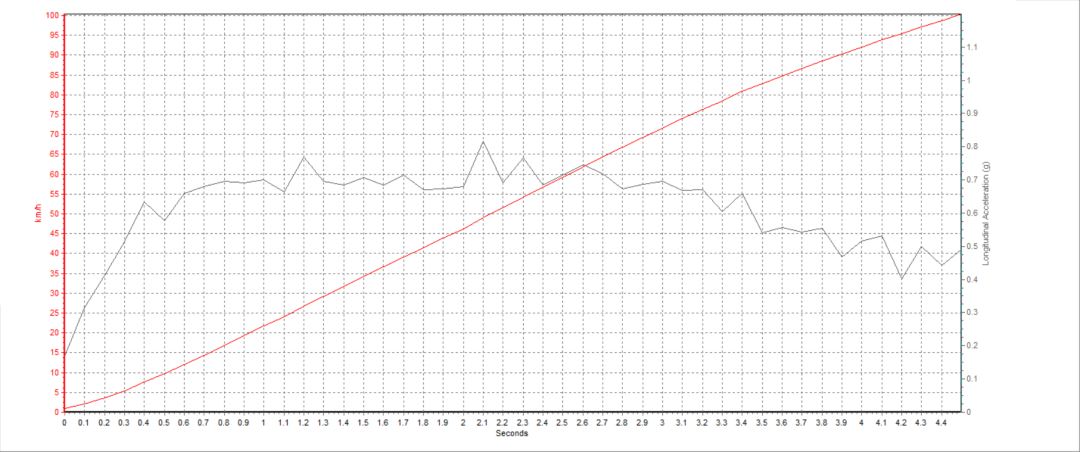

In addition, although there are three modes of economy, standard, and sport in the power mode of P7, the difference between these three modes is mainly in the initial stage of the accelerator pedal. If you continue to step deeply, the power output is very strong. From the results of our measurement, the acceleration time of the three modes is only about 0.1 second different, and there is not much difference in absolute acceleration capability.
Braking

The P7 all-series models come standard with 4-piston Brembo brakes. After our measurement, the braking distance of P7 is 36.4 meters, which is very good.
In terms of brake pedal feeling, the initial stage is soft, and there is a slight segment feeling in the feel of stepping on the brake pedal. But the release of braking force gradually deepens very linearly, and the overall braking performance is satisfactory enough.
Kinetic Energy Recovery
There are two modes of “strong” and “weak” for P7’s kinetic energy recovery. In the “strong” mode, it can achieve single-pedal operation to a certain extent, but the degree of kinetic energy recovery is not entirely related to the lifting of the accelerator pedal. The higher the vehicle speed, the less deceleration the kinetic energy recovery brings. As the vehicle speed continues to decrease, the deceleration of kinetic energy recovery gradually increases.

For friends who are not used to kinetic energy recovery, this calibration can avoid the discomfort caused by sudden throttle reduction and the large deceleration caused by kinetic energy recovery.
However, for friends who are familiar with single-pedal driving, there may be a certain discomfort at the beginning of the car, so we suggest adding a single-pedal mode that electric car owners prefer on this basis.In “Weak” mode, the driving experience is no different from that of a fuel-powered car. It is worth noting that P7’s brake pedal combines kinetic energy recovery, so even if you are not used to “single-pedal” driving, you can still maximize the use of kinetic energy recovery in a “seamless” manner, improve energy utilization, and reduce wear on the brake system. From the data released at the press conference, P7’s iBooster brake system has a recovery rate close to 100%.
Suspension
On the hardware level, P7’s suspension has very high specifications, with a front double-wishbone independent suspension and a rear five-link independent suspension, as well as a set of CDC dynamic damping.

The actual tuning has also reached the level of joint-venture brands, with very thorough filtering of small vibrations and no extra shakiness when encountering larger undulations, making it very crisp. Overall comfort is excellent.
However, it should be noted that only the top-performance models come standard with CDC active continuous damping system, so the performance of the suspension is limited to the performance models.
Steering
Although this is a performance model, the steering feel has little to do with “performance” and is more oriented towards comfort, just like the suspension tuning.

There is not much difference in intensity between the three steering modes. Even if you switch to Sport mode, there is still a certain amount of play, especially at high speeds. The direction is not precise enough and is not suitable for aggressive driving. If you drive in a relatively relaxed manner, the steering of this car is not a big problem.
NVH
I did not have too high expectations for NVH for a frameless car, but P7’s performance was quite surprising.

As an electric car, P7’s performance is good in low-speed conditions, similar to that of the Model 3. However, if you drive a Model 3 on a high-speed road, it’s like listening to music on the subway with normal headphones, and there will always be noise around your ears. In comparison, P7 feels like wearing noise-canceling headphones.# P7 High-speed Driving
Only when the speed of the vehicle reaches over 100 km/h, slight tire noise will enter the car. As for wind noise, P7 has done a better job, and at a speed of 120 km/h, only a little noise will come in at both sides of the A pillar base with an acceptable volume level.
Overall, P7 performs very well in terms of driving, except for a slightly flawed steering, and its completeness is very high, making it a powerful and comfortable car.
Intelligent Driving of Expectation
Intelligent driving is generally divided into “in-vehicle systems” and “driver assistance.” But unfortunately, we got the beta version of the system, which has not yet opened the driver assistance.
In the current test drive vehicle, we can experience only XPeng’s automatic parking system, and it is no exaggeration to say that XPeng’s visual fusion perception automatic parking system is currently the best system on the market.

First, let’s explain what visual fusion perception is.
Traditional automatic parking systems mainly rely on ultrasonic radar on the side of the vehicle to detect parking spaces. However, this detection method is limited in terms of detection distance and parking space identification, and the recognition rate is not high enough.
P7 with visual fusion perception can directly identify the parking space line through the camera. Therefore, even in environments with a 45-degree inclination or no car in front or behind, XPeng can still park the car into the parking space stably.
In practical use, XPeng P7’s automatic parking has no threshold. When driving normally, the car will automatically look for parking spaces. After parking, putting it in reverse gear, the car’s onboard screen will display various parking spaces along the way, and you only need to click and select the space you want to park in.
Because of the low threshold of use, high recognition rate, and successful parking rate, even someone like me who has never used automatic parking before will frequently opt to use it. I think this is enough to prove the success of this feature because it is effortless to use.

Let’s start with a conclusion: even if we expand the scope to the entire car market, P7’s in-vehicle system is still outstanding.
In terms of hardware, P7’s in-vehicle system consists of a 10.25-inch instrument panel and a 14.96-inch central control screen, and the resolution of the central control screen is 2400 x 1200 with high clarity.The car’s chip uses the currently strongest Snapdragon 820A for the chip, with a very fast touch response, and the navigation map is very smooth when zooming in or dragging.
Of course, fluency is only the basis of a “user-friendly” car machine. To have a good experience, operation logic is also crucial. The P7 is equipped with Xmart OS 2.0 system. Due to the screen layout changing from the original G3 vertical screen to a horizontal screen, the page layout has also changed.
In terms of operation, we can divide the car machine screen into four areas: left, middle, right, and top.
XPeng sets up a Dock column on the left side of the screen, which includes the most commonly used multimedia, vehicle settings, air conditioning, etc., and can be accessed at any time from any interface. Navigation is the default main interface of this car machine on any interface. There is a “return to the map” button at the bottom.
The second column on the left of the car machine is a scrollable menu, using a card-style design. The card displays thumbnails of navigation and multimedia information, and some quick operations can be performed here.
When you need to perform a more specific operation, the rightmost and largest area will display detailed information about the relevant function.
At the top of the screen, some commonly used shortcut keys are set. There is also a delicate design that when you click on the small person on the left, some commonly used driver functions will pop up. Here, you can perform a quick operation.
Clicking on the small person on the right will also pop up a small window, which mainly includes air conditioning and multimedia quick operations, which is very friendly for friends sitting in the front passenger seat, eliminating the need to stretch your hand to reach the leftmost functions.
Moreover, all the buttons of the P7 car machine have a large enough area, so even when driving, you can tap the content you want to operate very stably.
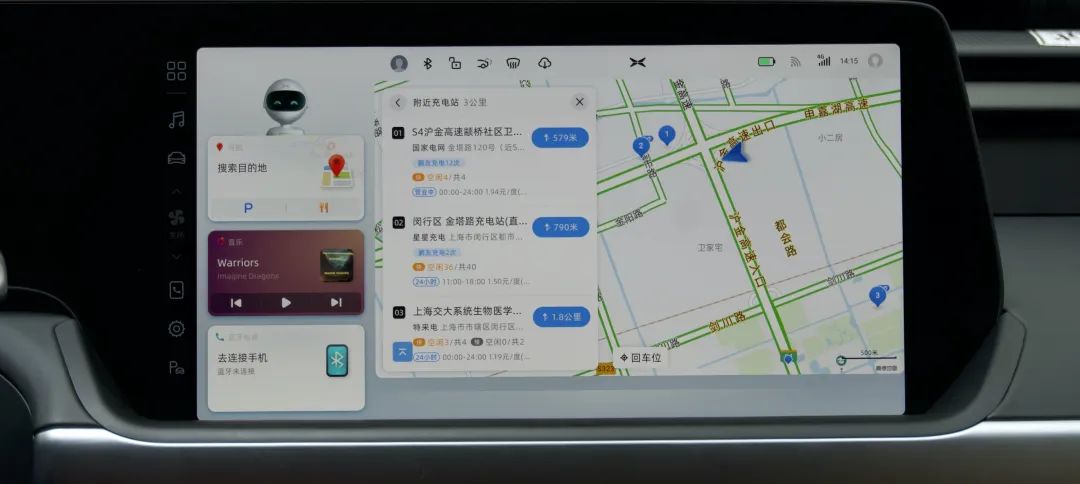
In terms of functionality, the navigation of XPeng P7 uses Gaode Maps and is deeply integrated with the car machine. In addition to deep integration on the UI, navigation can also automatically recommend nearby or along the route high-quality charging piles according to the remaining power. In short, this is a car machine system that can free you from mobile phone navigation.
In terms of multimedia, XPeng Automobile uses “Kugou” as the music source, which has a relatively rich music library, but requires membership to listen to the complete version of songs.
An interesting point is that when you use Bluetooth to connect to your phone to play music, the car machine will silently search for the same songs in the music library, and collect them in the Bluetooth playlist. You can also play these tracks without connecting to Bluetooth.
 One thing to complain about is that the multimedia interface design is a bit confusing, making it difficult to quickly find the content you want to play. Moreover, you cannot directly search for the music you want to play on the car system, and can only be done through the voice assistant. Unfortunately, in our shooting process, the language assistant Small P of P7 had a bug. Although it can be used normally, there is no sound.
One thing to complain about is that the multimedia interface design is a bit confusing, making it difficult to quickly find the content you want to play. Moreover, you cannot directly search for the music you want to play on the car system, and can only be done through the voice assistant. Unfortunately, in our shooting process, the language assistant Small P of P7 had a bug. Although it can be used normally, there is no sound.
Here we talk about 3 advantages and 1 disadvantage of Little P.
Firstly, Small P supports the execution of continuous commands. That is to say, there is no need to call out Small P first and then give instructions. You can directly use the wake-up word to say the following instructions, greatly reducing the complexity of using the voice assistant and improving the user experience.
Secondly, Small P has accurate language recognition, especially surprisingly accurate in recognizing English. In the process of testing endurance, in order to feel this Dynaudio audio system more, we made Small P play many English songs, but Small P did not have much challenge in recognizing our non-standard pronunciation and unpopular song names.
Thirdly, there is a button on each door, and each passenger can directly wake up Small P and give instructions through this button. After the introduction of this button, colleagues around us have become more proactive in using “voice control”.
The only disadvantage is that the pickup of P7 is for the entire car, so if the driver is doing voice control, the normal conversation of the rear passengers will directly affect the driver’s voice control.
In terms of hardware and UI design, P7 has achieved a level close to 100% of Model 3, and in terms of functionality, P7’s experience far exceeds Model 3.

Finally, let’s talk about this Dynaudio audio system equipped with P7. The whole car is equipped with 18 speakers and an independent amplifier with a total power of 600W, with an optional price of 18,000 yuan.
There are two lift-up loudspeaker devices on the left and right of the dashboard, which look very advanced when raised during music playback. There are also two of them on the left and right of the B-pillar roof, which can make the effect of the sound field better.
Although it costs 18,000 yuan for optional equipment, if the budget is sufficient, it is strongly recommended to choose this audio system for the following reasons:
-
It really makes driving and listening to music become an enjoyment;
-
In the case where you cannot listen to loud music at home, the car, as a private space, allows you to enjoy your favorite music to the fullest.3. The P7 with optional features also comes with a driver’s headrest sound system, which can be set to play music only through the driver’s sound system to avoid disturbing other passengers.
-
The adjustable tweeter can greatly enhance the vehicle’s style.

A few small details to note after experiencing:
-
Not sure if it’s due to the wide-angle camera, but the distance between the car and objects displayed on the screen is not very accurate, the screen shows a far distance, but the object is actually very close.
-
During a week-long test drive, there was one instance of the sound system bug where there was no sound. When calling the sound system, it would execute your command, but without any sound.
-
The page logic has many layers, and there are many UI button styles in each layer, which can create visual fatigue.
-
Clicking on the 3D virtual character “Little P” or the user login icon displayed above the screen will have different functions.
04 Static Experience
The appearance of the P7 is definitely an eye-catcher, with frameless doors, a sloping C-pillar, and 19-inch wheels, its entire design is very appealing to young people.


The P7’s exterior dimensions are 488018961450mm with a wheelbase of 2998mm. Speaking of the wheelbase, we must mention the P7’s space. Although the overall size of the vehicle has reached the level of a 5 series, the rear seat space performance is not as large as expected. After adjusting the front and rear seats, the P7 has only slightly more legroom than the Model 3.
The reason for this is due to the P7’s positioning as a coupe, which imposes many restrictions on the entire car including the body posture, design proportions, and wheelbase. To achieve a low center of gravity and a diving design, the engineers have elongated the distance from the front wheel axis to the A-pillar.
The proportion of the front of the car is slender, giving it a low, sporty posture, but although the wheelbase has reached C-class standards, there hasn’t been much increase in rear passenger space.
 # P7 Design
# P7 Design
The exterior design of P7 adopts a coupe-style, which appears more concise compared to the design of G3. The entire surface of P7 is more rounded as well.

The four-wheel drive high-performance version of P7 has blackened wheels, logos and tail labels, and the front and rear light groups are more delicate.
As for the interior design of P7, it is very concise but at the same time it shows a luxurious feel.
First of all, in terms of materials, most of the surfaces inside the car are wrapped in soft materials, and the seats are made of Nappa leather. The central armrest box is also wrapped in leather, and the leather craftsmanship is very solid, eliminating the feeling of inferiority that is typically seen in self-owned brands that use real leather.

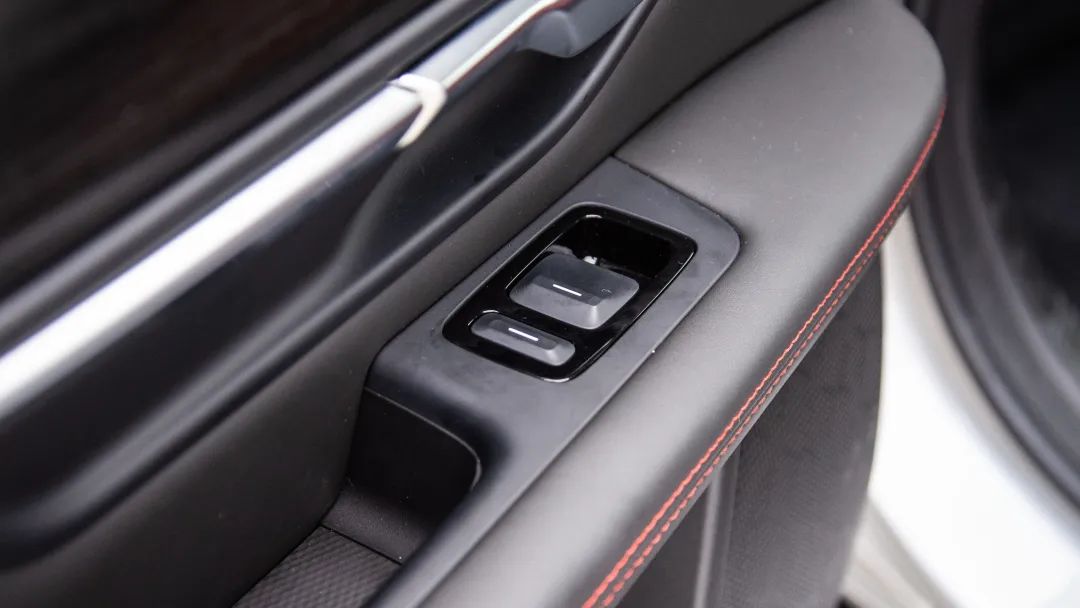
Secondly, the atmosphere of the interior is unified. P7’s door panel design is of good overall quality, sporting a uniform black color scheme, and with the same color stitching as the seats, combined a touch of chrome decoration, to add stability to it.
Although P7 is trying to create a luxurious feel, there are still some areas of detail that are slightly inadequate. It is hoped that there will be improvements in the official delivery version, specifically:
-
The storage compartment under the door panel and the simulated wood grain decoration are made of plastic, which lacks texture in terms of detail;
-
The center console uses soft materials, but the texture feels very similar to hard plastic;
-
The air vents and front part of the central armrest box below the chrome decoration on the center console still feel too plastic;
-
The physical buttons on the top of the steering wheel are made of plastic on both sides, not only being easy to leave fingerprints, but also being very loose.

The seats of P7 are mid-level, slightly hard, and the comfort and wrap of the front seats are good, while the rear seats are a bit short. A small detail to note is that when the driver’s seat of P7 is adjusted to the lowest position, the sit bones are closer to the floor, like the position of a real sports car.
 Translate the following Markdown Chinese text into English Markdown text in a professional way, retaining HTML tags inside Markdown and outputting only corrections and improvements.
Translate the following Markdown Chinese text into English Markdown text in a professional way, retaining HTML tags inside Markdown and outputting only corrections and improvements.
Finally, there are two small issues to note:
-
The process of electrically opening the charging port is very ceremonial, but the charging port must be opened by a button or key in the car, which is slightly inconvenient.
-
The top-model car does not have an electric tailgate and no foot-kick sensing opening. In this case, there is no physical opening button on the trunk door. The trunk can only be opened through the car interior or car key. If you happen to be out to load something without the key, you have to go back to the car to open the trunk, which is also inconvenient for others to use.

Overall, the P7 interior can be seen using a lot of careful thought, such as the adjustable speakers, color system combinations, a simple and streamlined center console design, and the use of silver trim. The overall feeling and unity performance will be better, but compared to traditional car companies, its understanding of luxury is slightly inadequate.
Final Note
If you want to summarize the overall performance of the P7 in one sentence, that would be “balance.” There are no major problems. The real-life range is basically on par with the Model 3. In terms of handling, it may not be as extreme as the Model 3, but the overall acceleration and other factors can meet daily needs.
The feeling of the entire driving experience is that of a light, powerful, comfortable car. The chassis performance is solid and the car won’t make you feel loose.
In terms of creating a sense of luxury, the P7 is much better than the Model 3. As an example, the Model 3’s interior can be described as too simple; the connection between the interior and luxury is even somewhat distant. P7 strives to create a luxurious atmosphere while maintaining a minimalist design.
The P7 indeed gives you another option for a sedan. The price for the top model with rear-wheel drive and ultra-long battery life is 276,900 yuan, with a NEDC range of 656km. This price is only for the standard range of the lowest-equipped Model 3. Therefore, if you want to buy a pure electric sedan, the P7 is worth a try!
Author: Delu
Editor: 63, Wang Songson



This article is a translation by ChatGPT of a Chinese report from 42HOW. If you have any questions about it, please email bd@42how.com.


